
World Of Controls understands the criticality of your requirement and works towards reducing the lead time as much as possible.
IS200DTTCH1A - Simplex Thermocouple Input Board is available in stock which ships the same day.
IS200DTTCH1A - Simplex Thermocouple Input Board comes in UNUSED as well as REBUILT condition.
To avail our best deals for IS200DTTCH1A - Simplex Thermocouple Input Board, contact us and we will get back to you within 24 hours.
SPECIFICATIONS:
Part No: IS200DTTCH1A
Manufacturer: General Electric
Product Type: Simplex Thermocouple Input Board
Function: DIN-rail mounting
Series: Mark VI
Number of Channels: 12
Span: -8 mV to +45 mV
Operating temperature: -30 to 65 ºC
Power Supply Voltage: 24 V dc
Board Size: 2.8 cm high x 8.6 cm
Weight: 0.45 kgs
Availability: In Stock
Country of Origin: USA
Manual: GEH-6421J
FUNCTIONAL DESCRIPTION:
IS200DTTCH1A is a Simplex Thermocouple Input Board manufactured and designed by General Electric as part of the Mark VI Series used in GE Speedtronic Control Systems. A small terminal board made for mounting on a DIN rail is the DTTC board. Twelve thermocouple inputs are present on the board, and a single 37-pin cable is used to connect it to the VTCC thermocouple processor board. Similar to the cable seen on the bigger TBTC terminal board, this one is also used here. Cold junction reference and on-board signal conditioning are exact replicas of those found on the TBTC board.
The VTCC can accommodate two DTTC boards, giving it a total of 24 inputs. Permanently mounted high-density Euro-Block type terminal blocks have two screw connectors for the ground connection (SCOM). The shield is connected to the screw every third one. The board is only offered in Simplex form. To save cabinet space, the terminal boards can be stacked vertically on the DIN rail.
INSTALLATION:
The DTTC board is mounted on the DIN rail by sliding into a plastic holder. The terminal block is connected directly to thermocouples. The 42-terminal Euro-Block type terminal block is fixedly installed on the terminal board. Commonly, #18 AWG wires are employed. The SCOM (ground) connection, which has two screws marked 41 and 42, should be as close to the center as feasible.
OPERATION:
The following diagram illustrates how the thermocouple terminal board is connected to the processor board, which houses the A/D converter. The only cold junction (CJ) reference on the terminal board is excited by VTCC. Through connector JA1, the 12 thermocouple signals, the CJ signal, and the connection to the identity chip (ID) are sent to the VME control rack R.
WOC has the largest stock of GE Speedtronic Control replacement spare parts. We can repair your faulty boards. WORLD OF CONTROLS can also supply unused and rebuilt backed-up with a warranty. Our team of experts is available round the clock to support your OEM needs. Our team of experts at WOC is happy to assist you with any of your automation requirements. For pricing and availability on any parts and repairs, kindly get in touch with our team by phone or email.
How many thermocouples can be connected to a Simplex Thermocouple Input Board?
The number of thermocouples that can be connected depends on the specific model of the input board. Some boards may support a single thermocouple input, while others may have multiple channels for connecting multiple thermocouples simultaneously.
What is the accuracy of temperature measurements with Simplex Thermocouple Input Boards?
The accuracy of temperature measurements can vary depending on factors such as the quality of the input board, calibration, and environmental conditions. However, most input boards offer high accuracy within a specified temperature range.
Can Simplex Thermocouple Input Boards be integrated with other control systems or software?
Yes, many Simplex Thermocouple Input Boards offer communication interfaces such as analog outputs, digital outputs, or serial communication protocols like Modbus or Profibus, allowing integration with various control systems and software platforms.